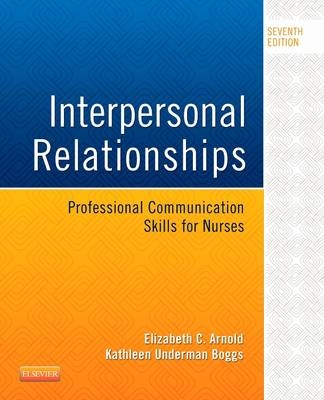
Interpersonal Relationships
Saunders (Verlag)
978-0-323-24281-3 (ISBN)
- Titel erscheint in neuer Auflage
- Artikel merken
Interactive exercises offer the opportunity to practice, observe, and critically evaluate your professional communication skills in a safe learning environment.
Practical guidelines describe how to modify communications strategies for various populations and situations including children, the elderly, end of life, clients with special needs, health teaching, stress, crisis, and professional colleagues.
Case examples help you develop empathy for clients' perspectives and needs.
Nursing, behavioral, developmental, family, and communication theories provide an essential foundation and a theoretical perspective for effective communication.
Learning objectives, chapter overviews, and a detailed glossary focus your study and help you absorb and retain key content.
NEW! A greater emphasis on communication, interdisciplinary theory, and interprofessionalism includes a focus on the nursing paradigm, nursing discipline, and ways of knowing.
NEW! Focus on QSEN competencies reflects current thinking on technology, safety, and evidence-based practice, especially as they relate to communication in nursing.
NEW! Discussion questions at the end of each chapter encourage critical thinking.
NEW! Clarity and Safety in Communication chapter addresses topics such as huddles, rounds, handoffs, SBAR, and other forms of communication in health care.
Kathleen Underman Boggs is a Family Nurse Practitioner and continues to practice. She is retired from teaching and is Associate Professor Emeritus College of Health and Human Services University of North Carolina Charlotte, Charlotte, North Carolina.
PART I: Conceptual Foundations of Interpersonal Relationships and Professional Communication Skills 1. Theory-Based Perspectives and Contemporary Dynamics 2. Professional Guides for Nursing Communication 3. Clinical Judgment and Ethical Decision Making 4. Clarity and Safety in Communication
PART II: Essential Communication Skills 5. Developing Therapeutic Communication Skills 6. Variation in Communication Styles 7. Intercultural Communication 8. Therapeutic Communication in Groups
PART III: Therapeutic Interpersonal Relationship Skills 9. Self Concept in Professional Interpersonal Relationships 10. Developing Therapeutic Relationships 11. Bridges and Barriers in Therapeutic Relationships 12. Communicating with Families 13. Resolving Conflicts Between Nurse and Client
PART IV: Communicating to Foster Health Literacy and Health Promotion and Prevention of Disease Among Diverse Populations 14. Communicating to Encourage Health Literacy and Health Promotion and Prevention of Disease 15. Health Teaching and Coaching 16. Empowerment-Oriented Communication Strategies to Reduce Stress
PART V: Accommodating Clients with Special Communication Needs 17. Communicating with Clients Experiencing Communication Deficits 18. Communicating with Children 19. Communicating with Older Adults 20. Communicating with Clients in Crisis 21. Communicating with Clients and Families at End of Life
PART VI: Collaborative and Professional Communication 22. Role Relationships and Interpersonal Communication 23. Communicating with Other Health Professionals 24. Communicating for Continuity of Care 25. Documentation in an Electronic Era 26. Communication at the Point of Care: Application of e-Health Technologies Glossary Index
| Erscheint lt. Verlag | 25.3.2015 |
|---|---|
| Verlagsort | Philadelphia |
| Sprache | englisch |
| Maße | 191 x 235 mm |
| Gewicht | 860 g |
| Themenwelt | Pflege ► Fachpflege ► Neurologie / Psychiatrie |
| ISBN-10 | 0-323-24281-2 / 0323242812 |
| ISBN-13 | 978-0-323-24281-3 / 9780323242813 |
| Zustand | Neuware |
| Informationen gemäß Produktsicherheitsverordnung (GPSR) | |
| Haben Sie eine Frage zum Produkt? |
aus dem Bereich



